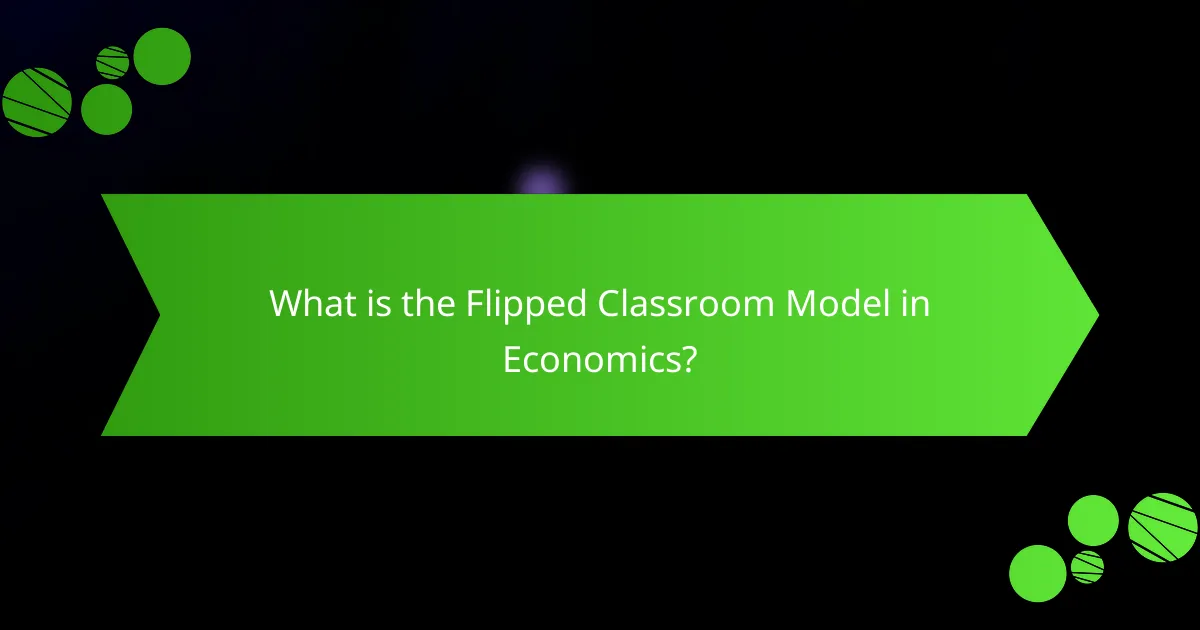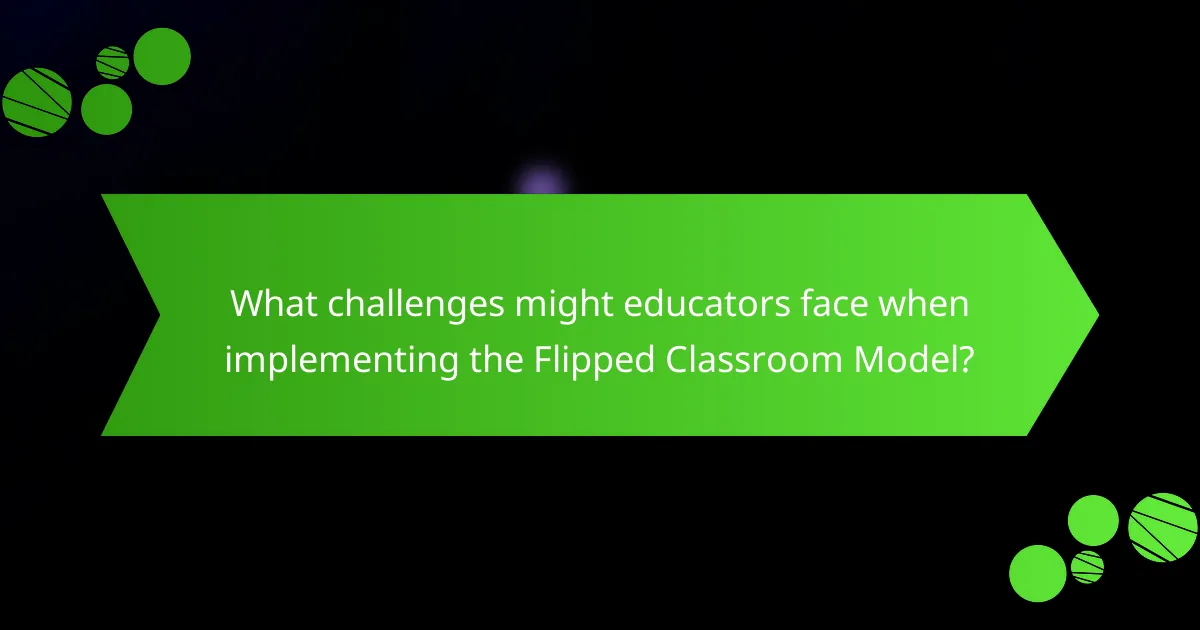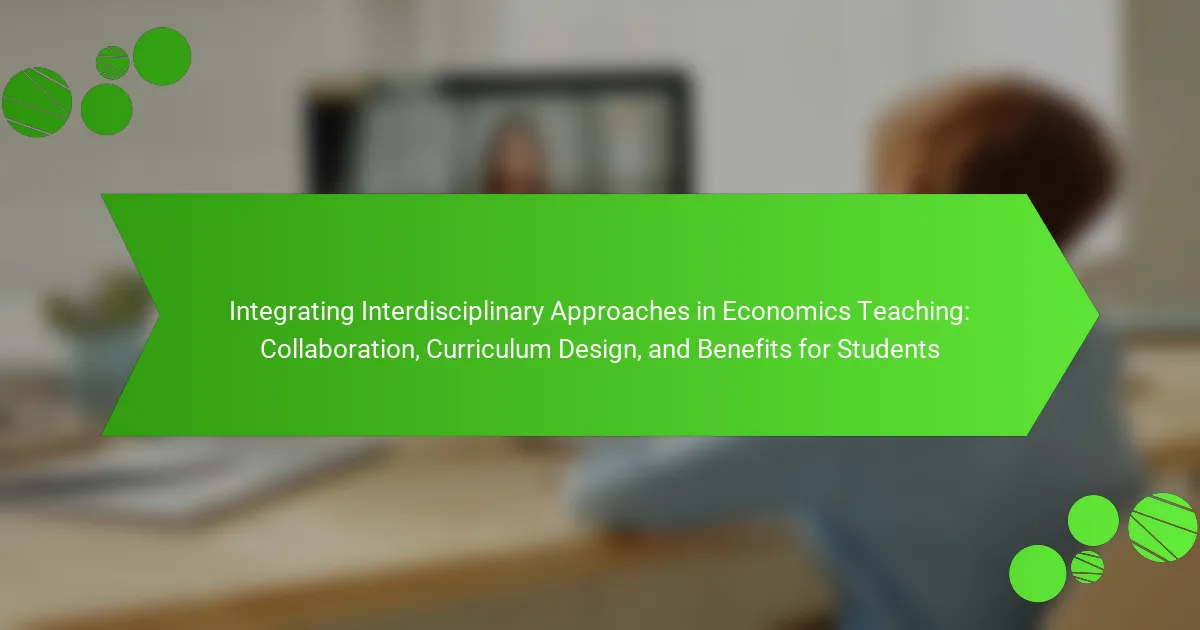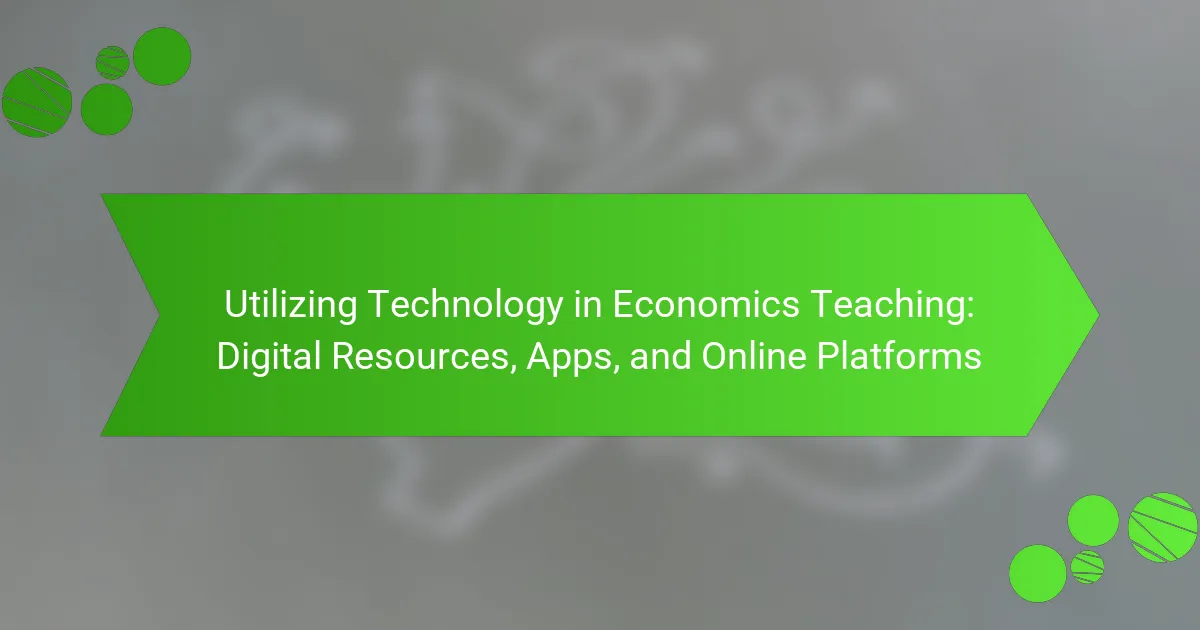The Flipped Classroom Model in Economics is an instructional strategy that reverses traditional teaching by having students learn new content at home and engage in interactive activities during class time. This approach enhances student engagement and promotes active learning, leading to improved academic performance and retention of economic concepts. Despite its benefits, educators face challenges such as technology access, resistance to change, time management, and the need for adapted assessment methods. This article explores the structure of the Flipped Classroom Model, its advantages for student engagement, and the obstacles educators encounter in its implementation.

What is the Flipped Classroom Model in Economics?
The Flipped Classroom Model in Economics is an instructional strategy where traditional teaching methods are inverted. In this model, students first engage with new content at home, typically through videos or readings. Class time is then used for interactive activities, discussions, or problem-solving exercises. This approach allows for deeper understanding and application of economic concepts during in-class sessions. Research shows that this model can enhance student engagement and improve learning outcomes in economics courses. Studies indicate that students often perform better in assessments when exposed to the Flipped Classroom Model, as it promotes active learning and critical thinking.
How does the Flipped Classroom Model differ from traditional teaching methods?
The Flipped Classroom Model differs from traditional teaching methods primarily in the sequence of content delivery and engagement. In traditional methods, instruction occurs during class time, with homework assigned afterward. The Flipped Classroom Model reverses this order. Students learn new content at home through videos or readings before class. Class time is then devoted to activities, discussions, and hands-on learning. This approach enhances student engagement and allows for more personalized instruction. Research shows that this model can lead to improved academic performance and deeper understanding of material. Studies indicate that students often report higher satisfaction and motivation in a flipped classroom setting compared to traditional methods.
What are the key characteristics of the Flipped Classroom Model?
The Flipped Classroom Model emphasizes student-centered learning. In this model, traditional lecture and homework elements are reversed. Students engage with instructional content at home, often via videos. Class time is then dedicated to interactive activities and discussions. This approach fosters deeper understanding through collaboration. It allows teachers to provide personalized support during class. Research shows that this model can enhance student engagement and performance. Studies indicate improved academic outcomes in various subjects, including economics.
In what ways does the Flipped Classroom Model enhance student learning in Economics?
The Flipped Classroom Model enhances student learning in Economics by promoting active engagement and personalized learning. In this model, students review lecture materials at home and engage in problem-solving during class. This approach allows for deeper understanding of economic concepts. Students can learn at their own pace, reviewing challenging materials as needed. Class time is dedicated to collaborative activities, fostering peer-to-peer learning. Research shows that this method increases student motivation and improves academic performance. A study by Bergmann and Sams highlights that students in flipped classrooms often outperform their peers in traditional settings. Overall, the Flipped Classroom Model creates a more interactive and effective learning environment in Economics.
What are the primary components of the Flipped Classroom Model?
The primary components of the Flipped Classroom Model include pre-class learning activities, in-class engagement, and assessment. Pre-class learning activities typically involve students reviewing instructional materials, such as videos or readings, before attending class. This allows students to familiarize themselves with the content at their own pace. In-class engagement focuses on interactive activities, such as discussions or group work, where students apply their knowledge. This component encourages collaboration and deeper understanding. Assessment is crucial for monitoring student progress and understanding. It helps educators adjust instruction based on student needs. These components work together to enhance the learning experience in a flipped classroom setting.
How are video lectures utilized in the Flipped Classroom Model?
Video lectures are utilized in the Flipped Classroom Model to deliver content outside of class time. This approach allows students to engage with the material at their own pace. They can pause, rewind, and replay lectures as needed. In-class time is then dedicated to interactive activities, discussions, and problem-solving. This method enhances student engagement and promotes deeper understanding. Research shows that this model improves learning outcomes. A study by Bishop and Verleger (2013) found that students in flipped classrooms performed better in assessments compared to traditional settings.
What role do in-class activities play in this model?
In-class activities in the flipped classroom model enhance student engagement and understanding. They provide opportunities for active learning and collaboration among students. During these activities, students apply concepts learned outside of class. This application reinforces their knowledge and skills. Research shows that active participation leads to better retention of information. In-class activities also allow instructors to assess student progress in real-time. They can adjust teaching strategies based on student needs. Overall, in-class activities are essential for maximizing the benefits of the flipped classroom model.
What benefits does the Flipped Classroom Model offer for Economics education?
The Flipped Classroom Model offers several benefits for Economics education. It enhances student engagement by allowing learners to absorb content at their own pace. This model promotes active learning during class time, where students can apply concepts through discussions and problem-solving activities. Research shows that students in flipped classrooms perform better on assessments compared to traditional settings. A study published in the Journal of Economic Education found that flipped learning increased student comprehension and retention of economic principles. Additionally, this approach fosters collaboration among students, as they often work in groups during class. Overall, the Flipped Classroom Model creates a more interactive and effective learning environment for Economics students.
How does the model improve student engagement and participation?
The flipped classroom model improves student engagement and participation by promoting active learning. In this model, students review lecture materials at home. This allows class time to be used for interactive activities. Students engage in discussions, group work, and problem-solving during class. Research shows that this approach increases student motivation. A study by Bishop and Verleger found that flipped classrooms can lead to higher academic performance. Additionally, students report feeling more responsible for their learning. The model fosters a collaborative learning environment. Overall, it shifts the focus from passive listening to active participation.
What impact does it have on students’ academic performance?
The flipped classroom model positively impacts students’ academic performance. Research indicates that this approach enhances engagement and understanding of course material. A study by Bergmann and Sams found that students in flipped classrooms scored significantly higher on assessments compared to traditional settings. Additionally, the model promotes active learning, which leads to improved retention of knowledge. Students report increased motivation and participation, contributing to better overall performance. Overall, the flipped classroom fosters an environment conducive to academic success.

How does the Flipped Classroom Model foster student engagement?
The Flipped Classroom Model fosters student engagement by promoting active learning and collaboration. In this model, students review instructional content at home and engage in hands-on activities during class. This approach encourages students to take ownership of their learning. Research indicates that active learning strategies can lead to higher retention rates and improved academic performance. A study by the National Center for Academic Transformation found that courses using the flipped model saw a 20% increase in student engagement levels. By shifting the focus from passive listening to active participation, the Flipped Classroom Model effectively enhances student involvement in the learning process.
What strategies can be implemented to enhance student interaction?
Implementing collaborative group projects enhances student interaction. These projects encourage teamwork and communication among students. Research shows that students engaged in group work demonstrate improved problem-solving skills. Incorporating technology, such as discussion forums, also promotes interaction. Online platforms allow students to share ideas and feedback effectively. Active learning techniques, like peer teaching, further stimulate student engagement. Studies indicate that peer teaching can increase understanding and retention of material. Regular feedback sessions create a space for open dialogue. This approach fosters a sense of community and belonging in the classroom.
How can technology be leveraged to facilitate engagement?
Technology can be leveraged to facilitate engagement by using interactive tools and platforms. These tools include learning management systems, video conferencing software, and online discussion forums. They allow for real-time interaction between students and instructors. For example, platforms like Zoom enable live discussions and collaborative projects. Additionally, tools like Kahoot and Quizlet promote active participation through gamified learning experiences. Research shows that students in technology-enhanced environments report higher engagement levels. A study by the Educause Center for Analysis and Research found that 80% of students felt more engaged when technology was integrated into their learning. This demonstrates the effectiveness of technology in enhancing student engagement in the flipped classroom model.
What types of collaborative activities are effective in a flipped classroom?
Effective collaborative activities in a flipped classroom include group discussions, peer teaching, and project-based learning. Group discussions allow students to engage with the material and share diverse perspectives. Peer teaching enables students to explain concepts to one another, reinforcing their understanding. Project-based learning promotes teamwork and problem-solving skills through real-world applications. Research indicates that these activities enhance student engagement and comprehension. For instance, a study by Freeman et al. (2014) found that active learning strategies significantly improve student performance in STEM fields.
How does student feedback influence the effectiveness of the Flipped Classroom Model?
Student feedback significantly enhances the effectiveness of the Flipped Classroom Model. It provides educators with insights into student understanding and engagement levels. This feedback allows instructors to adjust instructional strategies to meet students’ needs. For instance, students may indicate which topics require more clarification. Consequently, teachers can allocate more time to challenging areas. Research shows that incorporating student feedback leads to improved academic performance. A study by Bergmann and Sams (2012) highlights that adapting lessons based on student input increases comprehension. Thus, student feedback is crucial for optimizing the Flipped Classroom Model’s impact on learning outcomes.
What methods can be used to gather student feedback?
Surveys are a common method to gather student feedback. They can be conducted online or on paper. Surveys allow for quantitative data collection through multiple-choice questions. They also enable qualitative insights via open-ended questions. Another method is focus groups, which facilitate in-depth discussions among students. This method encourages students to express their opinions in a group setting. Additionally, individual interviews can provide detailed feedback from students. These interviews allow for personalized insights into the student experience. Classroom polls are another effective method for real-time feedback. They can be conducted using technology or simple hand-raising. Finally, reflective journals encourage students to articulate their thoughts regularly. This method promotes ongoing feedback throughout the course.
How can feedback be used to improve the learning experience?
Feedback can be used to improve the learning experience by providing students with specific insights into their performance. This allows learners to identify strengths and weaknesses. Timely feedback helps students adjust their learning strategies effectively. It promotes self-reflection and encourages active engagement in the learning process. Research indicates that feedback can enhance student motivation and achievement. According to Hattie and Timperley’s work on feedback, effective feedback can lead to a 0.73 effect size on student performance. This demonstrates that constructive feedback significantly impacts learning outcomes.

What challenges might educators face when implementing the Flipped Classroom Model?
Educators face several challenges when implementing the Flipped Classroom Model. One major challenge is access to technology. Not all students may have reliable internet or devices at home. This can create disparities in learning opportunities. Another challenge is resistance to change. Some educators may be accustomed to traditional teaching methods. This can hinder the adoption of new strategies. Additionally, educators may struggle with time management. Preparing pre-class materials requires significant planning and effort. There is also the challenge of student engagement. Some students may not take responsibility for their learning outside the classroom. Lastly, assessment methods may need adaptation. Traditional assessments may not align with the flipped model’s objectives. These challenges can impact the effectiveness of the Flipped Classroom Model.
How can teachers overcome resistance to the Flipped Classroom Model?
Teachers can overcome resistance to the Flipped Classroom Model by providing clear communication and training. Educators should explain the benefits of the model to students and parents. This includes improved engagement and personalized learning experiences. Regular training sessions can help teachers become comfortable with the technology involved. Additionally, sharing success stories from other educators can build confidence in the approach. Research indicates that a gradual implementation can ease the transition. According to a study by Bergmann and Sams, early adopters reported increased student motivation and understanding. By addressing concerns and highlighting positive outcomes, teachers can foster acceptance of the Flipped Classroom Model.
What are common misconceptions about the Flipped Classroom Model?
Common misconceptions about the Flipped Classroom Model include the belief that it eliminates direct teacher interaction. In reality, it enhances teacher-student engagement by allowing more one-on-one time during class. Another misconception is that students must learn independently without guidance. However, structured resources and support are provided to facilitate learning. Some think it only benefits advanced learners, but it can accommodate diverse learning styles and levels. Additionally, there is a belief that the model is solely about using technology. In fact, it focuses on the pedagogical approach, utilizing technology as a tool rather than a requirement.
How can educators address technological barriers?
Educators can address technological barriers by providing training and resources. Professional development sessions can enhance teachers’ digital skills. Access to reliable internet and devices is essential for all students. Schools can partner with local organizations to improve technology access. Offering technical support helps resolve issues quickly. Creating a user-friendly online platform encourages student engagement. Regular feedback from students can identify ongoing challenges. Implementing blended learning models can bridge gaps in technology access.
What best practices should educators follow when using the Flipped Classroom Model?
Educators should implement several best practices when using the Flipped Classroom Model. First, they must ensure that instructional videos are concise and engaging. Research shows that videos under 10 minutes maintain student attention more effectively. Second, educators should provide clear learning objectives for each video. This clarity helps students focus on key concepts. Third, they should encourage active learning during in-class time. Activities like discussions and problem-solving enhance understanding. Fourth, educators must offer timely feedback on student work. Feedback can guide students in their learning process. Fifth, they should integrate technology that supports collaboration. Tools like online discussion boards foster peer interaction. Lastly, educators must be flexible and adapt methods based on student needs. Adjusting strategies ensures that all learners benefit from the model.
How can lesson planning be optimized for a flipped classroom?
Lesson planning can be optimized for a flipped classroom by integrating pre-class instructional materials and active learning techniques. Teachers should create engaging video lectures or reading assignments for students to complete before class. This approach allows students to familiarize themselves with the content at their own pace. In-class time can then focus on collaborative activities, discussions, and problem-solving exercises. Research shows that this method increases student engagement and comprehension. A study by Bergmann and Sams found that students in flipped classrooms performed better on assessments compared to traditional settings. This evidence supports the effectiveness of flipped classroom strategies in enhancing learning outcomes.
What resources are available to support educators in this model?
Resources available to support educators in the flipped classroom model include online platforms, instructional videos, and lesson plan repositories. Websites like Edpuzzle and Flipgrid offer tools for creating interactive video lessons. Teachers can access platforms such as Khan Academy for economics content tailored to different learning levels. Additionally, resources like the Flipped Learning Network provide guidelines and best practices for implementation. Professional development workshops focused on flipped classroom strategies are also available through educational organizations. These resources enhance teaching effectiveness and improve student engagement in economics classes.
What tips can enhance the effectiveness of the Flipped Classroom Model in Economics?
To enhance the effectiveness of the Flipped Classroom Model in Economics, educators should prioritize structured pre-class materials. These materials can include videos, readings, and interactive content that introduce key concepts. Clear instructions on how to engage with these materials are essential. Educators should also encourage active participation during in-class sessions. This can involve discussions, problem-solving activities, and collaborative projects. Utilizing technology for real-time feedback can further enhance engagement. Research indicates that active learning strategies improve student understanding and retention (Freeman et al., 2014). Additionally, regular assessments can help gauge student progress and adjust teaching methods accordingly.
The Flipped Classroom Model in Economics is an innovative instructional strategy that reverses traditional teaching methods by having students engage with new content at home before participating in interactive class activities. This model enhances student engagement, promotes active learning, and allows for personalized instruction during class time, ultimately leading to improved academic performance and deeper understanding of economic concepts. Key components include pre-class learning activities, in-class engagement, and the use of technology to facilitate collaboration and feedback. The article will explore the structure, benefits, and strategies for effective implementation of the Flipped Classroom Model in Economics education.



